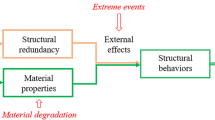Abstract
This paper introduces the concept of␣Integrated Structures and Materials Design (ISMD). ISMD combines materials engineering and structural engineering for the purpose of more effectively achieving targeted structural performance, by adopting material composite properties as the shared link. An application example, design of a bridge deck link-slab, is used to illustrate the essential elements of ISMD. It is shown that the composite hardened properties—tensile strain capacity, microcrack width, and Young’s Modulus, as well as composite self-consolidating fresh properties, are amongst the most important composite parameters that govern the targeted structural performance of safety, durability and ease of design and implementation. These are also properties that can be controlled in an Engineered Cementitious Composite—an ultra ductile concrete, by tailoring the ingredients for desired fiber, matrix and interface micromechanical parameters. Broad implications of ISMD on educational approach, research collaboration, and next generation infrastructure development, are briefly discussed.
Similar content being viewed by others
References
SEAOC (1995) Vision 2000: A framework for performance based engineering of buildings, Structural Engineers Association of California, Sacramento, CA
Li VC (2004) Strategies for high performance fiber reinforced cementitious composites development. In: Ahmad S, di Prisco M, Meyer C, Plizzari GA, Shah S (eds) Fiber reinforced concrete: from theory to practice, Proc. N. American/European Workshop on Advances in Fiber Reinforced Concrete, Bergamo, Italy, pp. 93–98
Li VC, Fischer G (2002) Reinforced ECC—an evolution from materials to structures. Proceedings of the First FIB Congress, Osaka, Japan, October 2002, pp.␣105–122
Caner A, Zia P (1998) Behavior and design of link slabs for jointless bridge decks. PCI Journal May–June:68–80
Kim YY, Fischer G, Li VC (2004) Performance of bridge deck link slabs designed with ductile ECC. ACI Struct J 101(6):792–801
Matsui S (1997) Technology developments for bridge decks—innovations on durability and construction (in␣Japanese). Kyouryou To Kiso (8):84–92
American Concrete Institute (1995) Building code requirements for structural concrete (ACI 318–95) and commentary (ACI 318R-95). American Concrete Institute, Farmington Hills, MI
American Association of State Highway and Transportation Officials (1998) AASHTO LFRD Bridge design specifications: Second Edition. AASHTO. Washington, DC, USA, pp. 5–41
Wang K, Jansen D, Shah S, Karr A (1997) Permeability study of cracked concrete. Cement and Concrete Research 27(3):381–393
Gilani A, Jansson P (2004) Link slabs for simply supported bridges. MDOT Report Number MDOT SPR-54181, Structural Research Unit, Construction and Technology Support Area, Michigan Department of Transportation. Lansing, Michigan
Wang S, Li VC (2005) Polyvinyl alcohol fiber reinforced engineered cementitious composites: material design and performances. In: Proc., Int’l Workshop on HPFRCC Structural Applications, Hawaii, May 2005
Li VC (2003) On Engineered Cementitious Composites (ECC) – A Review of the Material and its Applications. J Adv Concrete Technol 1(3):215–230
Li VC, Wang S, Wu C (2001) Tensile strain-hardening behavior of PVA-ECC. ACI Mater J 98(6):483–492
Li VC, Leung CKY (1992) Steady state and multiple cracking of short random fiber composites. ASCE J Eng Mech 118(11):2246–2264
Wang S (2005) Micromechanics based matrix design for ECCs, PhD Thesis, University of Michigan, Ann Arbor, April, 2005
Li VC, Wu C, Wang S, Ogawa A, Saito T (2002) Interface tailoring for strain-hardening PVA-ECC. ACI Mater J 99(5):463–472
Li VC, Lepech M (2004) Crack resistant concrete material for transportation construction. In: Transportation Research Board 83rd Annual Meeting, Washington, D.C., Compendium of Papers CD ROM, Paper 04–4680, 2004
Suthiwarapirak P, Matsumoto T, Kanda T (2002) Flexural Fatigue Failure Characteristics of an Engineered Cementitious Composite and Polymer Cement Mortars. J Materials Conc Struc Pavements JSCE 718(57):121–134
Lepech M, Li VC (2005) Design and field demonstration of ECC link slabs for jointless bridge decks. ConMat’05, Vancouver, Canada, August, 2005, CD-documents/1–05/SS-GF-05_FP.pdf
Zia P, Caner A, El-Safte AK (1995) Jointless bridge decks, research project 23241–94–4. Center for Trans. Eng. Studies, North Carolina State, pp. 1–117
Keoleian GA, Kendall A, Dettling JE, Smith VM, Chandler R, Lepech MD, Li VC (2005) Life cycle modeling of concrete bridge design: comparison of engineered cementitious composite link slabs and conventional steel expansion joints. In: ASCE J␣Infrastruct Syst 51–60
Acknowledgments
The authors thank the Michigan Department of Transportation and the National Science Foundation for funding this research (CMS-0223971, CMS-0329416, and CMS-0070035). Helpful discussions with S. Billington, M. Lepech, J. Lynch and H. Stang are acknowledged.
Author information
Authors and Affiliations
Corresponding author
Rights and permissions
About this article
Cite this article
Li, V.C. Integrated structures and materials design. Mater Struct 40, 387–396 (2007). https://doi.org/10.1617/s11527-006-9146-4
Received:
Accepted:
Published:
Issue Date:
DOI: https://doi.org/10.1617/s11527-006-9146-4




